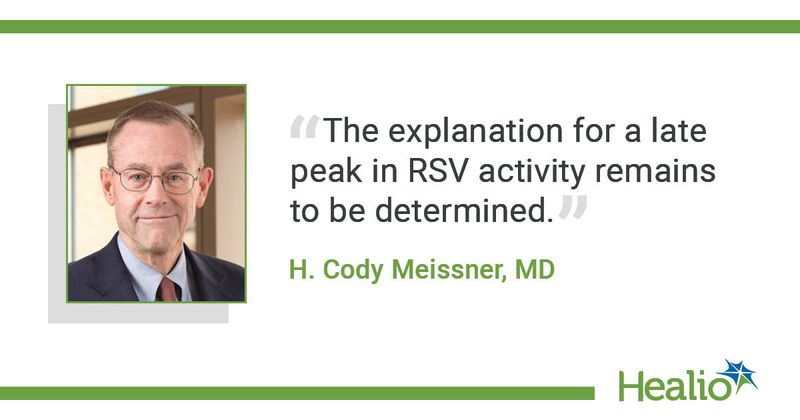Q&A: US sees late surge of RSV amid decline in COVID-19
According to the CDC, cases of respiratory syncytial virus surged in recent weeks — months later than the traditional seasonal peak of the common respiratory virus, which can cause serious infections in infants and older adults.
We spoke with H. Cody Meissner, MD, chief of the division of pediatric infectious diseases and professor of pediatrics at Tufts University School of Medicine, about the late surge and what it could mean for clinicians.

Healio: What is driving the current spike in RSV?
Meissner: The COVID-19 pandemic has changed much of what was considered normal behavior for humans, as well as for viruses. The epidemiology of RSV — as well as that of other respiratory viruses, such as influenza viruses — has changed dramatically over the past 12 to 18 months.
The explanation for the change in epidemiology of the respiratory viruses is not clear because so much has changed. Perhaps the change can be explained by masking, reduced interaction with family members, greater attention to hand hygiene, reluctance of parents to seek medical attention out of fear of SARS-CoV-2 exposure, or reduction in child care attendance. Perhaps a poorly understood interaction between two respiratory viruses that use the same portal of entry in the upper respiratory tract — SARS-CoV-2 and RSV — make infection less likely to occur. Whatever the reason, a marked reduction in cases of bronchiolitis has been noted globally.
In most areas of the United States, RSV activity typically begins to increase in late fall, peaks in winter months and wanes by early spring. This year, activity was remarkably slow during the typical months and has increased in May at the same time as COVID-19 detections have waned following widespread acceptance of the vaccine. Because the normal pattern of RSV seasonal disease cannot be fully explained, the explanation for a late peak in RSV activity remains to be determined.
Healio: What kind of clinical impact could a late surge of RSV have?
Meissner: The impact on pediatric hospitals is unlikely to be as profound on pediatric admissions as typically occurs during the winter months, when 50,000 to 100,000 infants in the first year of life are admitted for a brief hospital stay. The overall small number of hospital admissions due to bronchiolitis suggests a low likelihood of a surge in admissions in the summer months. In addition, the most recent CDC data suggest that the late peak in RSV admissions may already be in decline.
Healio: Where does RSV rank on the list of human infections in need of a vaccine?
Meissner: The large burden of RSV disease, particularly in children in the first year of life and adults aged older than 65 years — especially among those with comorbidities — indicates the pressing need for safe and effective RSV vaccines for use in different age groups. Another promising approach to control of RSV infection in infants is a single injection of a monoclonal antibody with a long half-life administered during or before onset of the RSV season.
References:
CDC. RSV national trends. https://www.cdc.gov/surveillance/nrevss/rsv/natl-trend.html. Accessed May 18, 2021.
CDC. RSV trends and surveillance. https://www.cdc.gov/rsv/research/us-surveillance.html. Accessed May 18, 2021.

